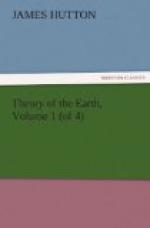M. Struve, in the Journal de Physique for January 1790, describes a mineral which he calls plombagine charbonneuse ou hexaedre; and gives for reason, parce qu’elle ressemble extremement au charbon de pierre schisteux, ou d’hexaedre. He says farther, “Il est tres commun, dans une roche qui forme un passage entre les granits et les breches, qu’on n’a trouvee jusqu’a present qu’on masses roulees dans le pays de Vaud.” He concludes his paper thus: “Ce fossile singulier ne paroit pas appartenir a la Suisse seule. J’ai dans ce moment devant les yeux une substance parfaitement semblable, si on excepte la couleur qui tient le milieu entre le gris de fer et le rouge modere; elle vient du pays de Gotha de la Friedrischs-grube, proche d’Umneau. On le regarde comme un eisenrahm uni a du charbon de pierre.”
The specimen which I have from Stair upon the water of Ayr, so far as I can understand, perfectly resembles this plombagine of M. Struve. It consumes very slowly in the fire, and deflagrates like plumbago with nitre. Now this comes from a regular coal stratum; and what is more remarkable, in this stratum is contained a true plumbago, Farther up the country, the Earl of Dumfries has also a mine containing plumbago along with other coal strata; and though the plumbago of these two mines have not all the softness and beauty of the mineral of the same species from Cumberland, they are nevertheless perfect plumbago.
I have a specimen of steatetical whinstone or basaltes from some part of Cumberland, in which is contained many nodules of the most perfect and beautiful plumbago. It is dispersed through this stone in rounded masses of all sizes from a nut to a pin’s head; and many of these are mixed with pyrites. There is therefore reason to believe that this plumbago had been in fusion.
Now, if we consider that every species of coal and every species of plumbago are equally, that is, perfectly combustible, and yield, in burning, the same volatile principles, differing only perhaps a little in the small quantity of fixed matter which remains, we shall be inclined to believe, that they have all the same origin in a vegetable substance; and that they are diversified by some very small composition of other matter. This being allowed, one thing is certain, that it is by the operation of mineral fire or heat that those combustible substances, however composed, have been brought to their present state of coal, although we are ignorant of the circumstances by which their differences and their peculiar chemical and mechanical qualities have been produced.
Let us resume in a few words. There is not perhaps one substance in the mineral kingdom by which the operation of subterraneous heat is, to common understanding, better exemplified than that of mineral coal. Those strata are evidently a deposit of inflammable substances which all come originally from vegetable bodies. In this state of their formation, those coal strata must all be oleagenous or bituminous. In many of them, however, these volatile parts are found wanting; and, the stratum is found in the state of the most perfect coal or caput mortuum. There, is, I presume, no other means to be found by which this eminent effect could be produced, except by distillation; and, this distillation perhaps proceeded under the restraining force of an immense compression.




